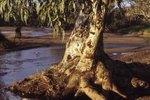
Water moccasins (Agkistrodon piscivorus) are venomous semiaquatic reptiles that live solely in the United States. They're also commonly referred to as cottonmouth snakes because of the pale interiors of their mouths. Water moccasins indeed possess fangs that assist them in administering their toxins. They, for the most part, are nocturnal in habit.
Water Moccasin Venom
Since water moccasins are venomous, their bites are dangerous to people. Their poison sometimes even has the power to end humans' lives. It isn't rare for people to see water moccasins, as they live not only in aquatic settings, but also on dry land. They typically are clandestine in nature, however, favoring staying out of peoples' sights. They also don't usually behave violently unless they feel incited to do so. If a water moccasin makes the move to bite a person, it's usually because he feels directly menaced. If a person tries to grab a water moccasin, for example, there's a strong chance the snake will bite.
Fangs and Venom
Water moccasins' fangs are situated on the top portions of their jaws. They're distinct from the rest of their teeth and are significantly longer than them. The fangs essentially are empty pipes that enable the passage of venom. Newborn water moccasins begin their lives already equipped with both their poison and fangs. Water moccasins shed their fangs from time to time, but prompt replacements always emerge. When water moccasins are in defense mode, they prominently display their fangs, along with the famous whiteness of their mouths.
Fangs and Hunting
When water moccasins go after their prey, they sink their fangs into them. This action pushes the poison into the fangs. When the venom arrives at the ends of the snakes' fangs, it goes inside of the prey. These meat-eaters focus heavily on fish and mammals alike. They aren't limited to those types of animals, however, and also frequently dine on reptiles, amphibians, birds and bugs. Water moccasins occasionally dine on rotting animal carcasses, too. It isn't even unheard of for water moccasins to eat fellow water moccasins. They are not at all selective in their feeding habits.
Spotting Water Moccasins
These independent snakes are big, usually somewhere between 2 and 4 feet long. Some specimens grow even longer than that. Color-wise, they're somewhat all over the map. Some water moccasins are practically black, while others are more yellow, yellowish-green or brownish. Their bodies are often covered in crossbands. Water moccasins' stomachs are lighter than the rest of them. Their big heads are triangular. If you ever see a snake that fits this physical description, keep your distance. Stay away from wild snakes in general. Water moccasins usually live in damp settings such as marshes. They are found in many other kinds of habitats, too, however, from bays to sloughs.
References
- University of Michigan Animal Diversity Web: Agkistrodon Piscivorus
- Savannah River Ecology Laboratory: Cottonmouth / Water Moccasin
- United States Geological Survey: Cottonmouth
- The IUCN Red List of Threatened Species: Agkistrodon Piscivorus
- Savannah River Ecology Laboratory: The Eastern Cottonmouth
- Loyola Center for Environmental Communication: Cottonmouth - Omnivore of the Wetlands
- Smithsonian National Zoological Park: Cottonmouth
Photo Credits
-
George Doyle/Stockbyte/Getty Images




